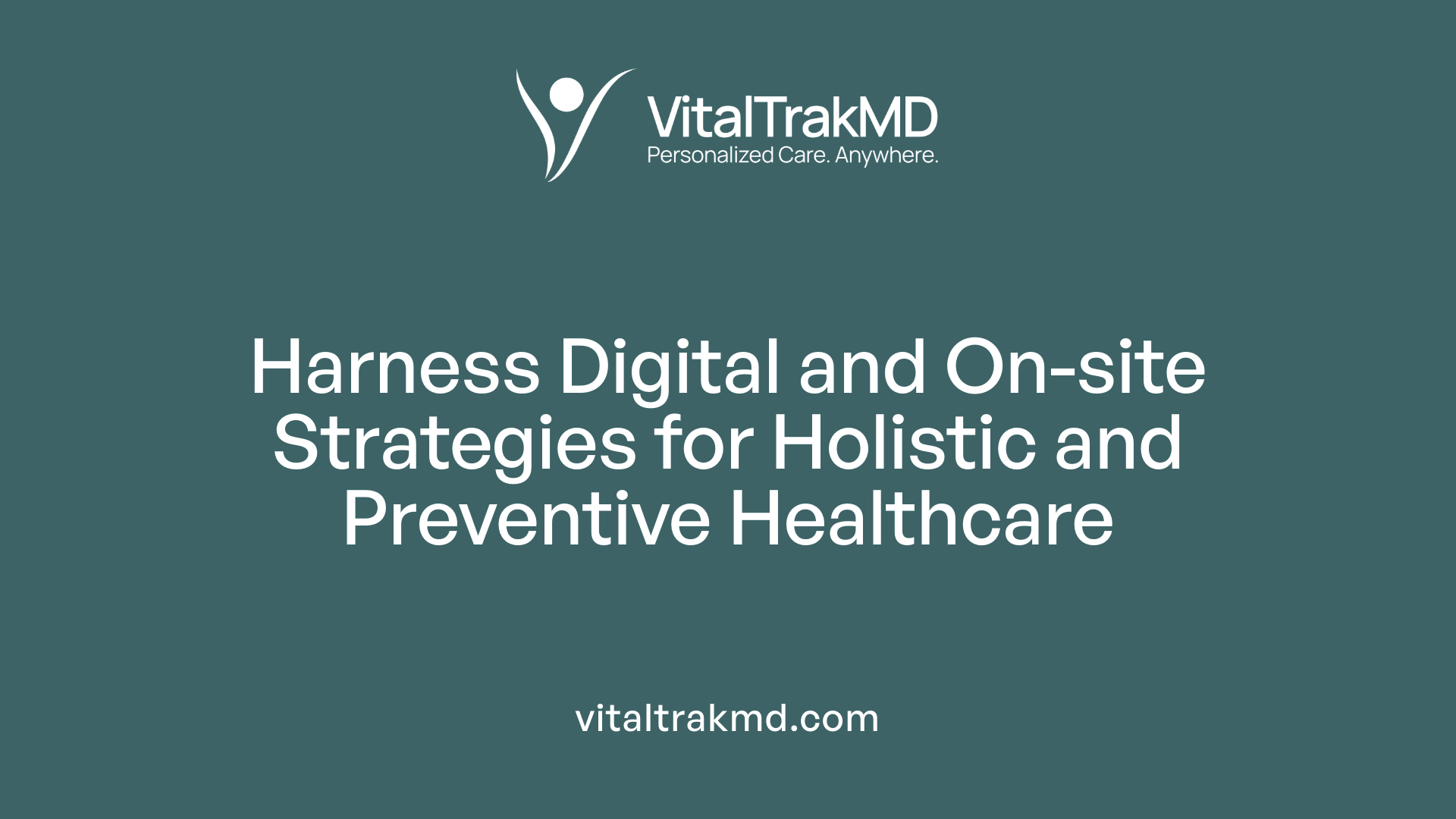Why Physicians Are Embracing Hybrid Wellness Programs

The Shift Toward Hybrid Wellness in Modern Medicine
The healthcare landscape is undergoing a profound transformation with the increasing adoption of hybrid wellness programs. Driven by technological advancements, pandemic-induced needs, and changing physician and patient expectations, hybrid models integrate in-person and virtual care to enhance accessibility, efficiency, and patient outcomes. This article explores why physicians are embracing these innovative approaches, the industry trends shaping their adoption, and the strategic implications for healthcare providers, all supported by scientific evidence and real-world examples.
Benefits and Advantages of Hybrid Wellness Models in Healthcare

What are the benefits and advantages of hybrid wellness models in healthcare?
Hybrid wellness models in healthcare offer a variety of significant benefits that improve the overall delivery and experience of care. One major advantage is enhanced patient accessibility. By combining virtual visits with in-person appointments, these models help eliminate obstacles like transportation issues and geographic barriers, making healthcare more reachable for underserved populations and those with mobility challenges.
Continuity of care is another key benefit. Regular communication through telehealth, remote monitoring, and digital platforms ensures consistent patient engagement and supports early detection of health issues. This ongoing oversight allows healthcare providers to manage chronic conditions more effectively and make timely interventions.
Moreover, hybrid approaches offer increased convenience and flexibility for patients. They empower individuals to choose how they receive care—whether through a face-to-face consultation or a virtual interaction—thus catering to personal preferences and busy lifestyles. This flexibility can lead to better appointment adherence and higher levels of patient satisfaction.
Cost savings are also notable. Hybrid models can reduce expenses for both patients and providers by decreasing unnecessary emergency visits, lowering overhead costs associated with in-clinic procedures, and streamlining administrative processes. For providers, these efficiencies translate into better resource allocation and the potential to serve more patients.
Overall, hybrid healthcare systems synergize the strengths of traditional and digital care to deliver more personalized, accessible, and efficient services. They adapt seamlessly to patient needs, ultimately fostering improved health outcomes and enhanced satisfaction in the healthcare experience.
Physicians' Motivations for Embracing Hybrid Wellness Programs
What are the reasons behind physicians adopting hybrid wellness programs?
Physicians are increasingly turning to hybrid wellness programs to better align with the evolving needs of both patients and healthcare practices. One primary motivation is the desire to enhance flexibility and improve work-life balance. By integrating virtual care options with traditional in-person visits, physicians can manage their schedules more effectively, reducing burnout and allowing for more personalized patient interactions.
Improving patient access and care quality is another key driver. Hybrid models widen reach, especially for patients in remote or underserved areas, providing easier access to specialists and continuous monitoring through telehealth and remote patient management tools. This approach not only elevates the quality of care but also accelerates timely interventions.
Addressing workforce challenges, such as staffing shortages and rising clinician stress, is crucial. Hybrid programs enable healthcare providers to distribute workload more evenly, promote remote work, and decrease the physical and administrative burdens associated with in-person care. These strategies bolster staff satisfaction and retention.
Financial sustainability also influences adoption. Hybrid care creates diversified revenue opportunities, supports cost-effective management, and sustains practice operations amidst fluctuating healthcare demands. Combining innovative technology with flexible workflows allows practices to remain resilient and competitive.
Overall, hybrid wellness programs are reshaping healthcare delivery, driven by the need for more adaptable, accessible, and sustainable models that meet the expectations of modern clinicians and patients alike.
Industry Trends Toward Hybrid and Remote Healthcare Approaches
 The healthcare industry is increasingly embracing hybrid and remote models, especially since the onset of the COVID-19 pandemic. Telehealth usage has exploded, with estimates showing a 38-fold increase compared to pre-pandemic years. Over half of Americans reported using telehealth services by 2024, with patient satisfaction reaching around 89%. This rapid expansion is supported by technological advancements such as wearable devices, AI integration, and telemedicine platforms that seamlessly connect providers and patients.
The healthcare industry is increasingly embracing hybrid and remote models, especially since the onset of the COVID-19 pandemic. Telehealth usage has exploded, with estimates showing a 38-fold increase compared to pre-pandemic years. Over half of Americans reported using telehealth services by 2024, with patient satisfaction reaching around 89%. This rapid expansion is supported by technological advancements such as wearable devices, AI integration, and telemedicine platforms that seamlessly connect providers and patients.
Healthcare leaders recognize the operational benefits of hybrid approaches. More than 80% of hospitals and clinics have adopted or plan to adopt hybrid care models, blending in-person visits with virtual consultations. These models not only improve access for patients—especially in rural or underserved areas—but also enhance provider flexibility and work-life balance.
Patient acceptance remains high, as many find virtual care more convenient, leading to increased patient engagement and satisfaction. Additionally, specialists and primary care providers can deliver more timely interventions, reducing wait times and overall healthcare costs.
Operationally, hybrid models support scalability. Hospitals and clinics can expand their services without significant physical infrastructure investments, leveraging technology to increase capacity and efficiency. The integration of electronic health records, wearables, and remote monitoring tools allows for continuous patient management outside traditional settings.
In summary, the healthcare landscape is shifting toward flexible, technology-driven hybrid approaches—guided by innovations in telemedicine, increased patient demand for convenience, and the need for efficient resource utilization—ensuring more accessible, personalized, and cost-effective care.
Organizational and Strategic Implications of Hybrid Wellness Programs
Implementing hybrid wellness programs in healthcare organizations carries various organizational and strategic benefits and challenges. These initiatives necessitate designing flexible, inclusive, and accessible health promotion activities that cater to diverse employee needs. For instance, incorporating virtual wellness resources, mental health support, and physical activity options appeals to both in-office and remote staff, addressing social isolation and digital fatigue.
Leadership support is vital for embedding wellness into the company culture. Leaders should actively promote participation, model healthy behaviors, and allocate resources to ensure sustainability. Creating a culture that values wellbeing requires consistent communication, recognition of achievements, and integration of wellness as a core organizational priority.
Strategically, organizations need to develop modern metrics for success, such as digital engagement levels, participation rates in virtual activities, utilization of mental health services, and impact on employee retention and productivity. Tracking these indicators allows for informed decision-making and continuous program optimization.
The positive impact of hybrid wellness programs extends beyond individual health benefits. They foster higher employee engagement, reduce burnout, and enhance collaboration across teams. This, in turn, supports talent attraction and retention—critical factors in competitive healthcare markets.
By aligning wellness strategies with broader organizational goals, healthcare providers can build resilient, healthier work environments. Effective communication about program benefits and ongoing evaluation ensures these initiatives remain relevant and impactful. Overall, adopting holistic hybrid wellness programs confers a strategic advantage by promoting a healthier workforce, improving organizational culture, and strengthening resilience amidst ongoing industry transformations.
Integration of Digital Health, Telehealth, and Virtual Care into Hybrid Strategies

How is digital health, telehealth, and virtual care integrated into hybrid wellness strategies?
Digital health, telehealth, and virtual care are becoming essential components of modern hybrid healthcare strategies by combining traditional in-person services with advanced digital solutions. This integration allows healthcare providers to deliver more flexible, accessible, and personalized care.
A fundamental aspect of this integration involves the use of telemedicine platforms that enable virtual consultations, remote monitoring, and electronic health record (EHR) systems that facilitate real-time data sharing. These tools help in managing conditions such as chronic diseases, mental health issues, and post-surgical care, improving patient engagement and health outcomes.
Seamless data sharing across digital platforms ensures that providers have comprehensive information at their fingertips, promoting better coordination among multidisciplinary care teams. This interoperability allows for timely interventions, personalized treatment plans, and continuous health monitoring outside the clinical setting.
However, successful integration depends on addressing digital literacy gaps and infrastructure limitations. Efforts to improve access include community education programs, investments in broadband connectivity, and user-friendly digital interfaces designed for diverse populations.
Personalized digital interventions, such as tailored health apps, reminders, and remote coaching, help meet individual needs and preferences, further enhancing the effectiveness of hybrid care.
Overall, integrating digital health into hybrid wellness strategies provides a robust framework for delivering high-quality, patient-centered care that adapts to the evolving landscape of healthcare needs and technological advancements.
Physicians' Attitudes and Perceptions of Hybrid Healthcare Models

What are physicians' attitudes and perceptions towards hybrid healthcare models?
Physicians generally view hybrid healthcare models positively, considering them a promising way to enhance patient access, care quality, and operational efficiency. They recognize that combining face-to-face visits with virtual encounters enables better management of chronic diseases, mental health, and underserved patient populations, reducing unnecessary emergency department visits and hospitalizations.
Many physicians appreciate that hybrid models align with core professional values by fostering more patient-centered care and encouraging interdisciplinary collaboration. These models also provide physicians with opportunities to engage more meaningfully with patients through longer consultations and timely follow-ups.
However, physicians also express caution in adopting telehealth broadly. Concerns about technological barriers, such as reliable internet access and user-friendly platforms, are common. Workflow disruptions and the need for appropriate clinical protocols also pose challenges. Despite these hurdles, most perceive hybrid healthcare as a step in the right direction, capable of revolutionizing healthcare delivery if supported with systemic infrastructure.
Overall, physician attitudes are supportive but emphasize the importance of proper training, technological support, and adherence to clinical standards to fully realize the benefits of hybrid models.
Promoting Preventive, Holistic, and Personalized Healthcare through Hybrid Programs
 Hybrid wellness programs combine digital health tools with on-site activities to foster a comprehensive approach to individual well-being. These initiatives focus on preventive care, addressing physical, mental, and emotional health, thus promoting holistic treatment.
Hybrid wellness programs combine digital health tools with on-site activities to foster a comprehensive approach to individual well-being. These initiatives focus on preventive care, addressing physical, mental, and emotional health, thus promoting holistic treatment.
Personalized assessments and fitness tracking enable tailored interventions that meet each employee's unique needs. This proactive health management strategy encourages early detection and intervention, reducing the risk of chronic illnesses and improving overall health.
Digital platforms play a vital role by providing data-driven insights into health trends, participation levels, and behavioral patterns. These insights allow organizations to continually optimize programs, offering more precise support and guidance. At the same time, on-site activities such as fitness classes, health screenings, and wellness workshops complement digital efforts, creating a balanced, engaging environment.
Leadership commitment and ongoing program evaluation are essential for sustaining long-term outcomes. Together, these elements help cultivate a culture of wellness, emphasizing personalized, preventative care that can lead to better health outcomes and increased organizational productivity.
The Future of Healthcare Delivery
The evolving landscape of healthcare is increasingly characterized by hybrid models that blend technological innovation with human-centered care. As physicians recognize the numerous benefits—ranging from improved access and patient satisfaction to operational efficiencies and workforce wellbeing—the trend towards hybrid wellness programs is set to expand further. These models promote preventive, holistic, and personalized approaches that can address longstanding healthcare challenges such as disparities, workforce stress, and resource limitations. The strategic integration of digital health, telemedicine, and virtual care into organizational frameworks signifies a resilient, adaptable, and patient-centric future, driven by continuous technological progress and a shared commitment to better health outcomes for all.
References
- The Benefits Of Hybrid Work Models In Healthcare
- assessing views of doctors and nurses on hybrid ...
- Healthcare's Future Is a Hybrid Model
- Hybrid Healthcare
- 5 Good Reasons Employers and Health Plans Should ...
- Why More Doctors Are Embracing Integrative Medicine
- Hybrid approach to telehealth effective in rural communities
Recent articles
Want to Feel Better and Live Healthier?
Join hundreds of patients taking control of their health with personalized care that fits their life – not the other way around.
Rated 4.8/5 by 32+ customers







